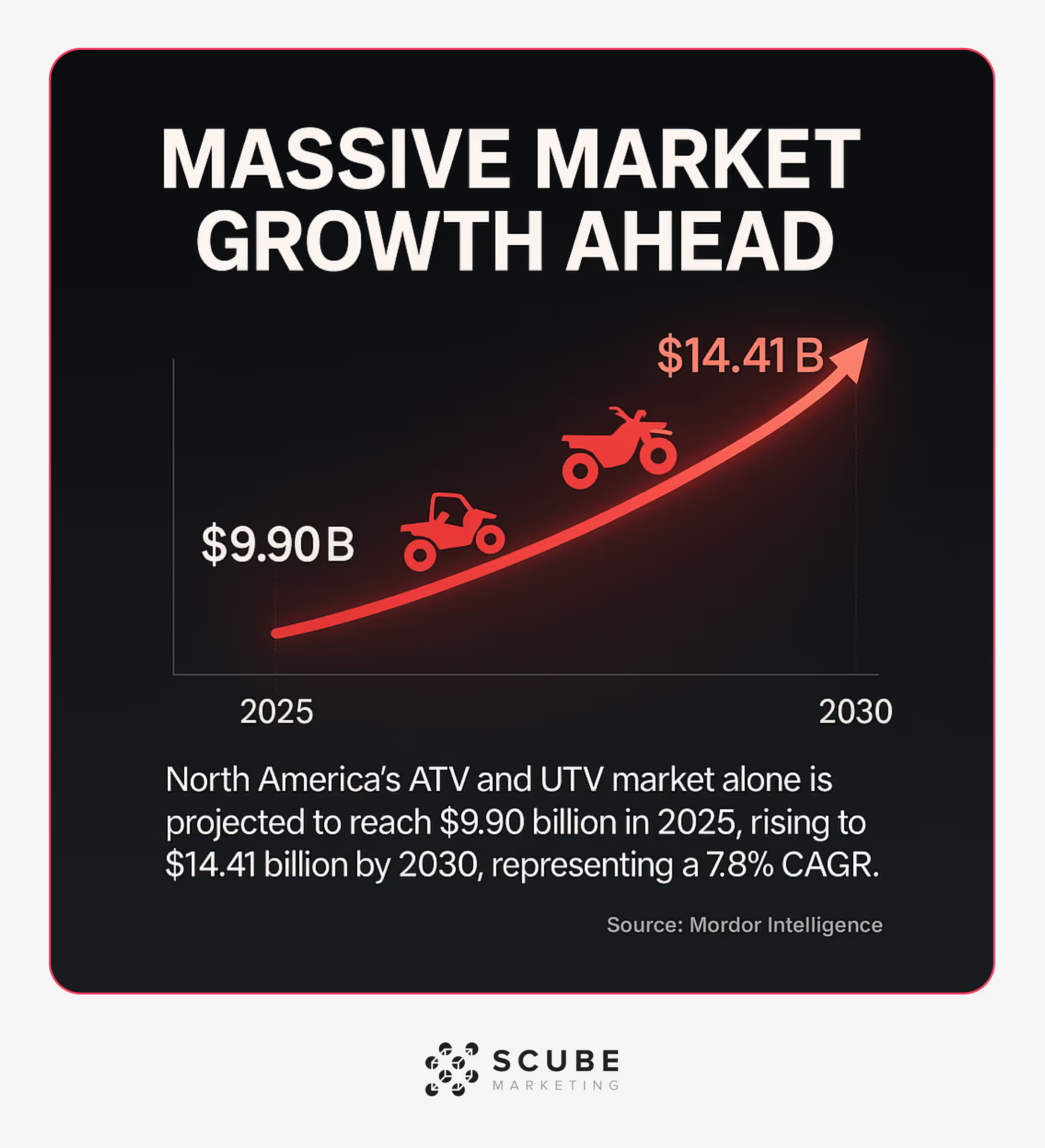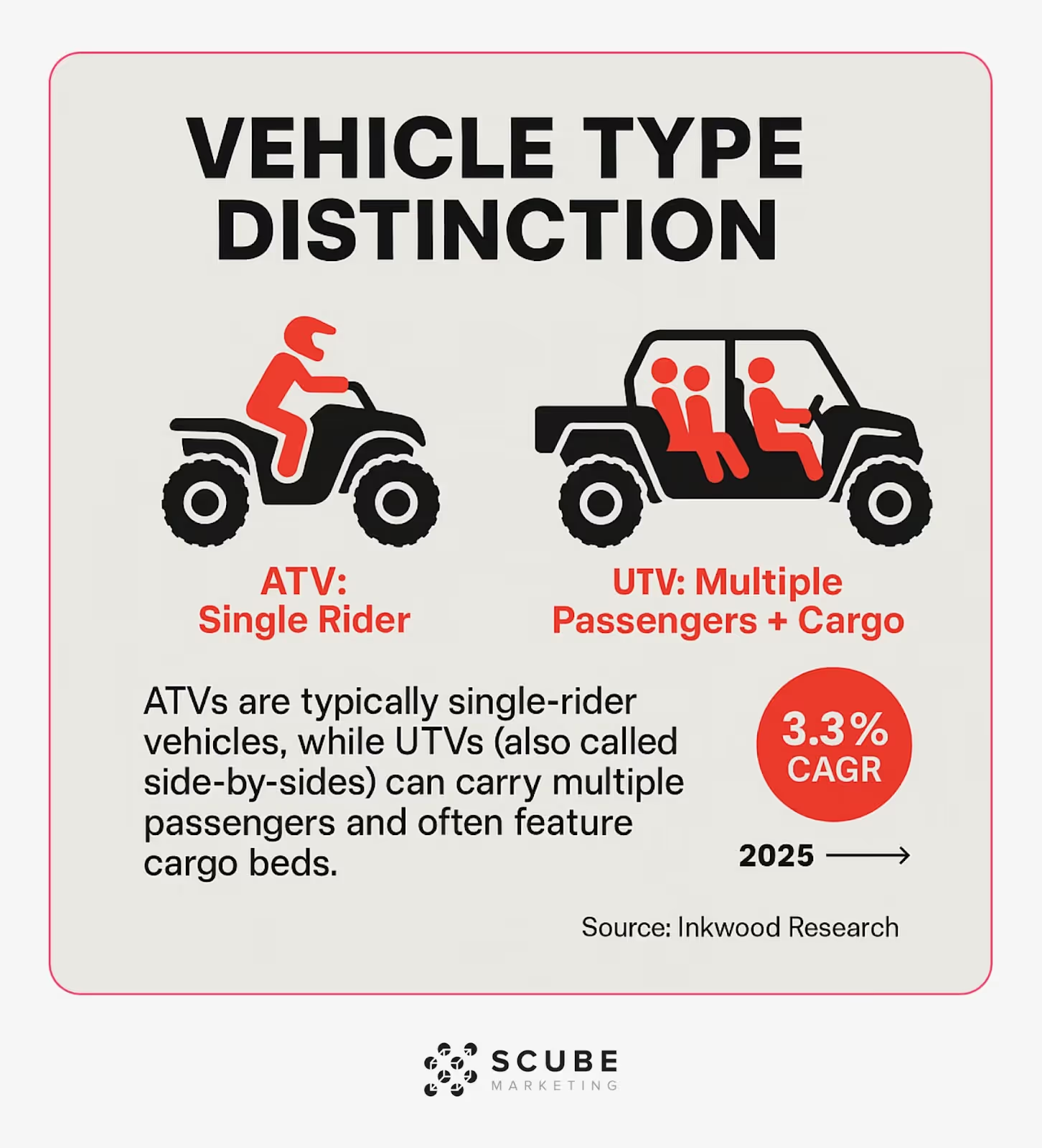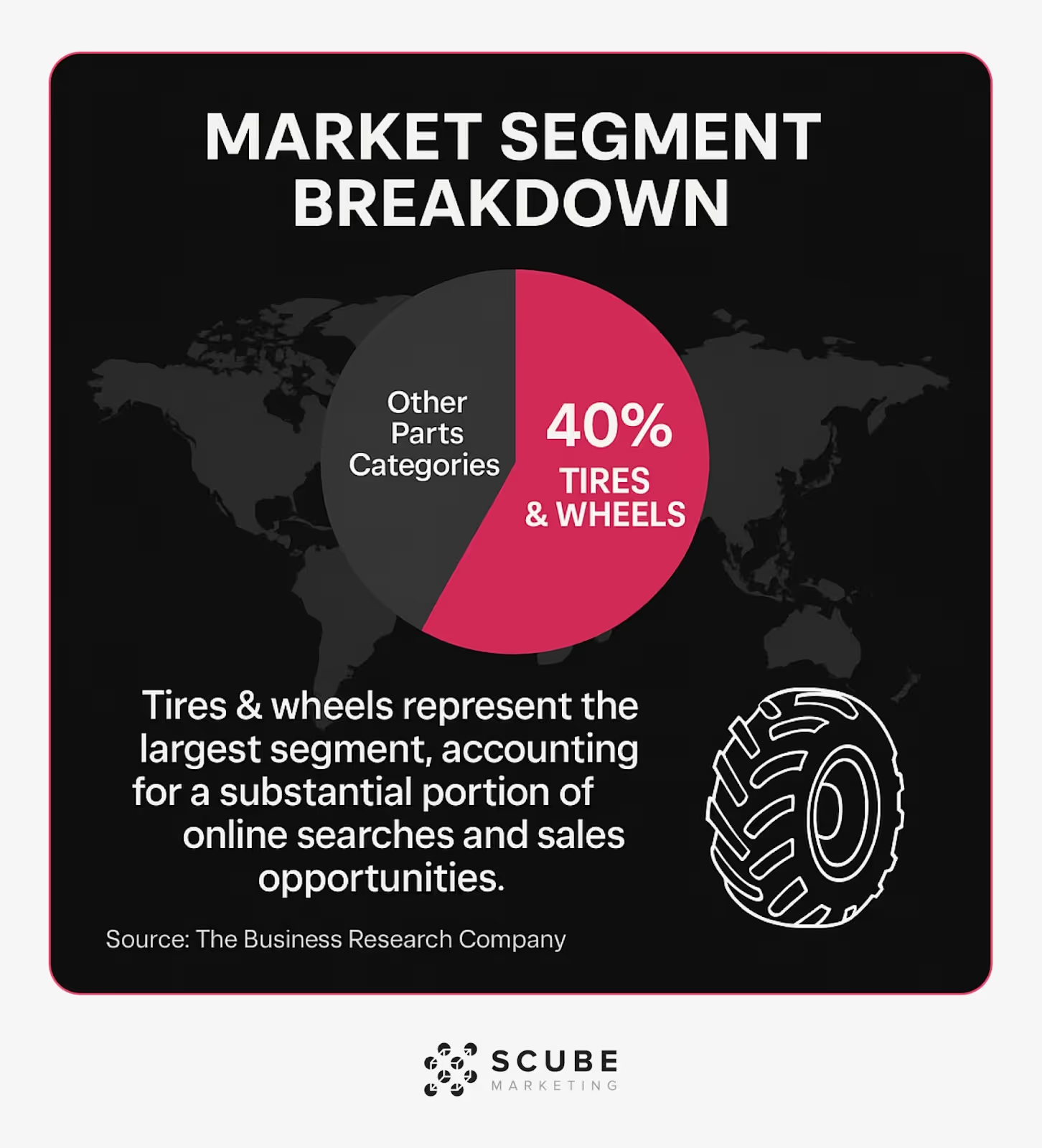
The ATV and UTV parts market represents a massive opportunity for online retailers who know how to properly optimize their digital presence. As I work with aftermarket parts businesses, I continue to see how proper SEO transforms struggling operations into thriving eCommerce businesses. It's not magic – it's methodical strategy applied consistently.

The numbers paint a clear picture of this opportunity: North America's ATV and UTV market alone is projected to reach $9.90 billion in 2025, rising to $14.41 billion by 2030, representing a 7.8% CAGR. (Source: Mordor Intelligence)
In this guide, I'll share proven SEO strategies specifically tailored for ATV and UTV parts retailers. You'll learn which keywords actually drive sales, how to optimize your product pages for maximum visibility, and which technical factors matter most for ranking in this competitive niche.
Effective SEO starts with understanding your market. For ATV and UTV parts sellers, this means recognizing both the size of the opportunity and the specific segments within it.

The global ATV/UTV market is projected to reach $13,114.59 million by 2032, growing at a 4.80% CAGR from 2025 to 2032. (Source: Inkwood Research)
This growth stems from increasing recreational activities, growing adoption in agriculture and other industries, and rising consumer interest in off-road vehicles. For parts retailers specifically, the ATV parts market is estimated at $1,602 million in 2025, with a projected 3.3% CAGR through 2033. (Source: The Business Research Company)
.avif)
Understanding this landscape helps inform your SEO strategy by identifying where your potential customers are located, what types of vehicles they own, and how they search for parts online.
The ATV and UTV market divides into several key segments, each providing valuable insights for keyword targeting. These divisions help structure your SEO approach.

When we look at vehicle types, the distinction is clear: ATVs are typically single-rider vehicles, while UTVs (also called side-by-sides) can carry multiple passengers and often feature cargo beds. (Source: Inkwood Research)
These vehicles operate on various fuel types, including gasoline, diesel, electric, and even solar power options, creating distinct customer segments with different parts needs. (Source: Inkwood Research)

Within the parts categories themselves, tires & wheels represent the largest segment, accounting for a substantial portion of online searches and sales opportunities. (Source: The Business Research Company)
*Note: Regional breakdowns beyond North America are estimates based on overall market proportions as specific data beyond North America wasn't provided in the source material.
This market knowledge forms the foundation of an effective SEO strategy. With this understanding, we can now explore how to conduct keyword research specifically for ATV & UTV parts.
Effective keyword research is the cornerstone of any successful SEO campaign for ATV and UTV parts. I've found that the most successful aftermarket parts retailers take a methodical approach to identifying and targeting the right search terms.
The key is understanding how your potential customers actually search online. ATV and UTV owners use distinct terminology and specific model references when looking for parts, making generic approaches ineffective.
When conducting keyword research for online auto parts sales, focus on terms that show clear purchase intent and model specificity.
Based on my experience working with parts retailers, I've identified several high-value keyword categories that consistently drive qualified traffic and conversions.
The most valuable searches typically combine brand, model, and part information. These highly specific searches (like "Polaris Ranger 1000 windshield") indicate a ready-to-buy customer who knows exactly what they want.
Problem-based searches represent another valuable category. Terms like "fix ATV carburetor problems" or "UTV overheating issues" represent users seeking solutions you can provide through both products and educational content.
Maintenance queries like "how to change UTV oil" or "ATV air filter replacement" offer excellent content marketing opportunities that can later funnel users toward relevant products.
This table helps illustrate where to focus your efforts based on your business goals. For immediate sales, the Brand + Model + Part and Compatibility categories typically deliver the best results.
The most valuable traffic often comes from long-tail keywords—longer, more specific phrases that might have lower search volume but typically have much higher conversion rates.
For ATV and UTV parts, long-tail keywords are particularly valuable because they often indicate a buyer who knows exactly what they want. Here are strategies for identifying these opportunities:
When implementing these keywords in your aftermarket auto parts eCommerce strategy, focus on creating valuable content that naturally incorporates relevant terms rather than forcing keywords where they don't belong.
Once you've identified your target keywords, the next step is implementing them effectively throughout your website. On-page SEO refers to all the measures you can take directly within your website to improve its position in search rankings.
For ATV and UTV parts retailers, on-page optimization presents unique challenges due to the technical nature of products and the importance of fitment information. A structured approach to content organization becomes essential.
Let's explore the critical on-page elements that make the biggest difference for parts retailers.
Your product pages will likely drive the majority of your revenue, making their optimization absolutely critical. Several key elements deserve your attention when optimizing these pages.
Title tags should include the brand, model compatibility, part name, and a key benefit. For example: "Polaris RZR XP 1000 Windshield - Scratch-Resistant, Perfect Fit" tells both users and search engines exactly what the page offers.
Product descriptions need special attention. Write unique, detailed descriptions that answer common questions about fitment, installation, and benefits. Avoid manufacturer boilerplate content that appears on dozens of other sites.
This optimization approach ensures your product pages provide both search engines and users with clear, valuable information that increases the likelihood of ranking and converting.
Category pages act as valuable entry points for broader search terms and help establish site structure. They deserve special attention in your SEO strategy.
Add 200-300 words of unique content at the top of category pages explaining the product type, common applications, and selection advice. This content should target broader terms like "UTV windshields" or "ATV performance exhausts".
Implement robust filtering by vehicle compatibility, price range, brand, and features. These filters not only improve user experience but also help search engines understand the breadth of your offerings.
Include links to relevant subcategories with descriptive anchor text. This internal linking strategy helps distribute page authority and creates clear paths for both users and search crawlers.
Proper inventory management for auto parts connects directly to SEO success by ensuring your category pages accurately reflect available products and prevent frustrating out-of-stock situations.
Technical SEO elements are particularly important for ATV and UTV parts websites due to the complexity of parts compatibility, inventory management, and the need for detailed product information.
The foundation of technical SEO for parts retailers is creating a website architecture that both search engines and users can easily navigate. This includes logical categorization of products, proper URL structure, and clear internal linking.
Let's examine the most important technical elements for parts retailers.
Organize your products in a way that makes sense to users searching for specific parts. A logical hierarchy helps both users and search engines understand your site organization.
Consider structuring your site with vehicle type (ATV vs UTV) at the top level, followed by brand (Polaris, Honda, Can-Am), then model series, specific models, part categories, and finally specific parts.
This structure allows users to find parts through multiple navigation paths, whether they start by vehicle or by part type. It also creates natural keyword opportunities at each level of the hierarchy.
Clear breadcrumb navigation further enhances this structure by showing users exactly where they are in your site hierarchy and providing additional internal linking opportunities.
One technical aspect unique to parts retailers is vehicle fitment data integration. Creating a robust system that allows users to search by vehicle can dramatically improve both SEO and user experience.
This typically involves a comprehensive database of vehicle makes, models, and years; the ability to filter all products by compatibility; clear compatibility information on every product page; and the option to save vehicle selections for future visits.
When implemented properly, this system helps search engines understand product compatibility and improves your chances of appearing in specific searches like "2019 Polaris Ranger 1000 windshield."
For the automotive and motorsports industry, fitment data represents one of the most valuable technical assets you can develop, affecting everything from SEO to conversion rates.
Content marketing is particularly effective for ATV and UTV parts retailers because enthusiasts are often seeking information about modifications, maintenance, and performance improvements.
The right content strategy positions your store as an authority while capturing valuable search traffic at various stages of the buying journey. It also helps you rank for informational queries that can later convert to sales.
Let's explore the most effective content approaches for parts retailers.
Based on my experience with aftermarket parts retailers, certain content types consistently perform well in terms of both traffic and conversion potential.
Buyer's guides provide comprehensive comparisons of options for a specific part category. For example, "The Ultimate Guide to UTV Windshields" can rank for numerous search terms while helping customers make informed decisions.
Installation tutorials with step-by-step guides, photos, and videos showing how to install specific parts provide immense value to customers while showcasing your products in action.
Problem-solution content that addresses common issues your products solve helps capture customers actively looking for solutions, putting your products in front of them at the perfect moment.
This table helps illustrate how different content types align with customer journey stages, allowing you to create a comprehensive content strategy that captures traffic at every point in the buying process.
One of the most effective content strategies for parts retailers is creating content that directly answers customer questions. These questions often become long-tail keywords that can drive highly qualified traffic.
Sources for identifying these questions include customer service inquiries, reviews and Q&A sections on your products, forums and social media groups, search console data showing query variations, and "People also ask" sections in search results.
For example, if you sell UTV windshields and notice many customers asking "Will a Polaris RZR 900 windshield fit a 1000 model?", create content specifically addressing cross-compatibility between models.
Creating a research-based content strategy for automotive aftermarket parts ensures your content addresses actual customer needs rather than assumed interests.
Implementing SEO strategies is only half the battle—measuring their effectiveness is equally important. For ATV and UTV parts retailers, tracking the right metrics helps you understand what's working and where to focus future efforts.
Let's explore the key metrics and tools that provide the clearest picture of your SEO performance.
Several metrics provide particularly valuable insights for parts retailers looking to gauge SEO effectiveness.
Organic traffic volume shows the number of visitors coming to your site through unpaid search results. This basic metric serves as your first indicator of SEO success, with consistent growth being the goal.
Conversion rate from organic traffic reveals what percentage of those organic visitors actually make a purchase. This metric helps you understand if you're attracting the right kind of traffic.
Page-level performance data shows which specific pages attract the most traffic and conversions. This granular view helps you identify your most successful content and product pages for further optimization.
For eCommerce analytics that drive results, combine your SEO metrics with other marketing data to get a complete picture of how customers find and interact with your store.
One of the most common questions I get from parts retailers is: "How long until we see results from SEO?" The reality is that SEO is a long-term strategy, especially in competitive markets.
In the first 1-3 months, expect to focus on technical improvements, content strategy development, and initial content publication. These foundational elements rarely produce immediate ranking changes.
From months 3-6, you should start seeing initial ranking improvements for long-tail keywords, increased indexing of your content, and some traffic growth. This is often where businesses get discouraged, but patience is essential.
The 6-12 month period typically brings significant improvements for primary keywords, noticeable traffic increases, and conversion improvements. This is when your earlier work begins to pay dividends.
After 12+ months of consistent effort, you should see competitive keyword rankings, substantial traffic and revenue growth, and clear ROI realization. The key is consistency and patience throughout this process.

Implementing effective SEO strategies for your ATV and UTV parts business can dramatically increase visibility, traffic, and sales in this growing market. The key is taking a structured approach that addresses all aspects of search optimization—from technical foundations to content development.
Remember that the ATV and UTV parts market is projected to continue its strong growth trajectory, with the North American market alone reaching $14.41 billion by 2030. (Source: Mordor Intelligence) Positioning your business now through effective SEO will help you capture a growing share of this expanding market.
By focusing on the specific strategies outlined in this guide—targeted keyword research, thorough on-page optimization, solid technical foundations, and valuable content creation—you'll build sustainable organic traffic that converts into sales.
If you're ready to implement these strategies but need expert guidance, our team at Scube Marketing specializes in helping aftermarket parts retailers develop and execute effective SEO campaigns. We understand the unique challenges of the automotive and powersports markets and can help you achieve sustainable growth through search optimization.
Whether you implement these strategies yourself or work with a partner, the important thing is to start now. The sooner you begin optimizing your site for search, the sooner you'll start seeing the benefits of increased organic visibility in this competitive market.